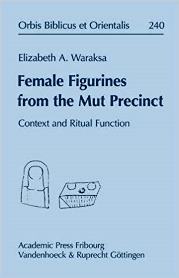
This study concerns the ceramic female figurines excavated by Johns Hopkins at the Precinct of Mut in Luxor, Egypt between 2001 and 2004. The figurines date from the New Kingdom to the Late Period (ca. 1550-332 BCE). Ceramic figurines are frequently overlooked by archaeologists, art historians, and social historians because they lack the aesthetic qualities usually associated with Egyptian art. However, the Hopkins-excavated figurines display features that mark them as standardized ritual objects. I argue that ceramic female figurines were produced in workshops, utilized by magician/physicians in healing rituals, and regularly snapped and discarded at the end of their effective <lives>. This is a new, broader interpretations for objects that have previously been considered as toys, dolls, concubine figures, and – most recently – votive <fertility figurines.>
Chapter 1 presents a brief history of the Mut Precinct and summarizes the work of John Hopkins at the site. It also addresses the current state of figurine studies in Egyptology, including a critique of the <fertility figurine> theory. Finally, I present a typology for the Mut Precinct figurines.
Chapter 2 is a detailed study of the materials and manufacture of ceramic female figurines. I suggest that the figurines were manufactured by craftsmen in state-sponsored workshops, and that the red hue of many figures signals that the objects were malevolent and ultimately to be destroyed.
Chapter 3 presents translations and commentary for magico-medical spells calling for female figures of clay, which demonstrate how female figurines functioned in magical rituals. Chapter 3 also discussed a new term for <clay figurines.> Finally, a survey of magico-medical texts calling for other types of clay figurines is presented, highlighting the widespread use of such figures.
Chapter 4 reviews the salient conclusions of the study, and discusses the use of ceramic female figurines at the Mut Precinct specifically.
This new interpretations of Egyptian female figurines broadens our understanding of objects often called <crude> and placed in the realm of women by demonstrating that ceramic female figurines were manufactured and acquired by men, and manipulated to heal a variety of patients. This study will undoubtedly encourage future studies of archaeological finds in concert with magico-medical texts.

